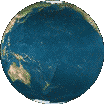
THE SUN VIEWED FROM EARTH
Image Credits: NASA/JPL Solar System Simulator developed by: David Seal
FOV: 30° (degrees) Magnification: 1x (naked eye) Earth's Location Around Sun Sun's Location in Constellations
L O A D I N G 

 W A R N I N G ! It is never safe to look directly at the real Sun with the naked eye! Moreover, looking at it through a telescope or binoculars without adequate safeguards—even for an instant—can cause permanent blindness! NEVER DO IT! To learn how to safely "observe" the real Sun, consult the professionals at your local planetarium or observatory.
W A R N I N G ! It is never safe to look directly at the real Sun with the naked eye! Moreover, looking at it through a telescope or binoculars without adequate safeguards—even for an instant—can cause permanent blindness! NEVER DO IT! To learn how to safely "observe" the real Sun, consult the professionals at your local planetarium or observatory.
FOV: 1.1° (degrees) Magnification: 27x
Click on the labels directly above to compare the current apparent size of the Sun to its apparent sizes when Earth is at its perihelion and aphelion, its least and greatest distances from our parent star. This will clearly show the Sun's maximum and minimum apparent sizes in the course of a year. These can be verified in the animation below.
As you study the Sun's sizes and distances in the images above at various times of year, two points will become obvious. First, the closer the date is to the first few days of January, the closer you'll have to look to see any difference between the Sun's current apparent size and its size at Earth's perihelion. Likewise, the closer the date is to the first few days of July, the closer you'll have to look to see any difference between the Sun's current apparent size and its size at Earth's aphelion. This confirms a fact that a great number of persons find surprising
—that Earth is actually closest to the Sun in the Northern Hemisphere's winter, NOT its summer!






Of course, the Sun's changing apparent size, as well as when it reaches its maximum and minimum, effect how much solar radiation each hemisphere receives—both on a particular date and cumulatively in a year's time. More- over, they likewise directly effect the frequency, type and duration of solar eclipses, as well as the most favorable times of year when they can occur. This latter consideration can be examined in more detail by checking out the Current Apparent Sizes of the Sun and Moon.
And though they appear much smaller in our skies than the Sun, don't forget to also always check out the Current Apparent Sizes of the Planets.
Bonus: Sun's Current Position Over Earth

The bonus view above can help you get a sense of where a location on the current sunlit half of our planet can see the Sun in its sky. The closer a location is to the view's center, the higher the Sun will be in its sky. Likewise, the closer a location is to the edge of the above globe, then the closer the Sun will be to its horizon. And don't forget—Earth rotates to the east (left to right in the image above). So, generally speaking (in all places except the polar regions), the Sun is currently rising at the "left edge" of Earth, and setting at its "right edge".
Simulator Image Notes: 1) Fields of View are measured horizontally. 2) Light-Travel Time is not included in calculated times. 3) Sun is viewed with its local north "upward", i.e. in the 12:00 midnight direction.
Home Intro News Gallery Sky-Gifts Bonuses Tips
Learning Ctr Help Links Credits Legal Contact Us
© 2007-
by Gary M. Winter. All rights reserved.
Interested in political cartoons and humor?
Check out The HIPPLOMATS™.
SkyMarvels, Sky Marvels, SkyMarvels.com, CURRENT VIEW OF THE SUN FROM EARTH. Sun's Current Distance, Sun's Current Apparent Size, celestiaforall, CELESTIA, astronomy, space, simulations, animations, downloadable astronomy posters, stars, planets, Inner Planets, Outer Planets, Inferior Planets, Superior Planets, moons, asteroids, comets, Oort Cloud, galaxy, galaxies, Milky Way, Andromeda, globular clusters, binaries, quasars, black holes, supermassive black holes, telescope, telescopes, planetarium, software, freestuff, satellites, add-ons, addons, scripts, eclipses, Solar Eclipses, Lunar Eclipses, Solar Eclipse Finder, Lunar Eclipse Finder, mutual eclipses, transits, occultations, Solar System, CELES-TOOLS, celeSTARrium, CELX, CELX programming, Freebies, multiple views, atronomical unit, light year, parsec, meteors, meteor showers, Perseids, Geminids, Leonids, barycenter, time, Time Zones, tides, alignments, conjunctions, oppositions, seasons, apogees, perigees, aphelion, perihelion, Earth, Luna, Mercury, Venus, Mars, Jupiter, Galilean Moons, Io, Europa, Ganymede, Callisto, Saturn, Titan, rings, Uranus, Neptune, Triton, E-MSpectrum, electromagnetic spectrum, astronaut, equinoxes, solstices, precession, rotation, spin, inclination, tilt, Ecliptic, orbits, ellipse, parabola, hyperbola
